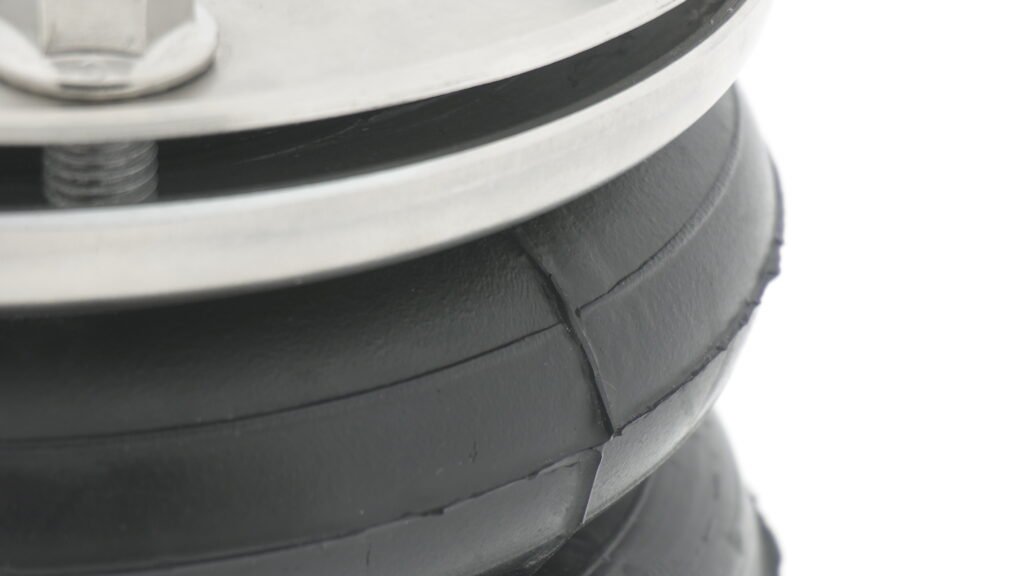
Identifying and Resolving Air Bellows Issues Efficiently
Maintaining air bellows in peak condition is crucial for ensuring long-term performance and operational efficiency. In our troubleshooting workshops, we guide technicians through common air bellows issues, offering practical solutions and preventive maintenance strategies. Understanding failure modes and identifying warning signs early can significantly extend the lifespan of air bellows systems, improving reliability and reducing downtime. Standard air bellows are designed for pressures up to 8 bar, while high-strength versions can handle 12 bar. Selecting the appropriate material, such as NBR, EPDM, or Chlorobutyl, ensures compatibility with specific working environments. Additionally, air bellows are available in single, double, and triple convolution designs, which influence their load-bearing capacity and deflection properties. Using the correct bore size and air connection type prevents leaks and ensures optimal performance in pneumatic applications.
Common Symptoms of Air Bellows Failures
Technicians working with industrial air bellows must recognize early warning signs of potential issues. Some of the most common symptoms include:
- Irregular inflation: Uneven pressure distribution can indicate leaks or blockages, often due to contaminated air supply or misaligned components.
- Excessive vibration: A compromised air bellow may no longer absorb shocks effectively, reducing overall damping efficiency and leading to mechanical failure.
- Loss of pressure: A steady decline in pressure often points to punctures, valve failures, or worn-out sealing rings, requiring immediate repair.
- Abrasion damage: Wear and tear from repeated cycles can weaken the rubber bellows structure, especially in high-cycle applications where continuous movement is required.
- Visible cracks or deformities: Structural damage can compromise air spring integrity and performance, leading to complete failure and potential system shutdown.
Diagnosing Air Bellows Performance Issues
Troubleshooting starts with a structured approach to diagnosis. During our workshops, we emphasize systematic inspection methods:
Step 1: Visual Inspection
- Examine the air spring for surface cracks, leaks, or bulging, using high-intensity lighting and magnification tools for precision.
- Check mounting brackets and air fittings for signs of wear, corrosion, or misalignment, ensuring secure fastening to avoid unnecessary movement.
Step 2: Pressure Testing
- Use calibrated pressure gauges to measure inflation levels accurately and detect pressure fluctuations beyond design tolerances.
- Compare measured values to manufacturer specifications to determine acceptable tolerance levels and identify performance deviations.
Step 3: Load Testing
- Evaluate load distribution across air bellows, ensuring maximum deflection does not exceed design limits under full load conditions.
- Detect any inconsistencies in performance under varying load conditions, checking for excessive deflection or irregular force application.
Step 4: Leak Detection
- Apply a soapy water solution to detect air leaks along seals, hose connections, and crimped fittings, ensuring air tightness.
- Inspect air lines for loose fittings, punctures, or deterioration due to chemical exposure, replacing compromised components when necessary.
Preventive Maintenance Strategies for Air Bellows
Our troubleshooting workshops stress the importance of regular maintenance. Implementing these strategies ensures optimal air spring longevity:
- Regular Inspections: Conduct monthly checks for rubber degradation, pressure loss, and fatigue cracks, ensuring early issue detection.
- Proper Alignment: Ensure mounting hardware is aligned to prevent uneven stress, reducing torsional strain and increasing operational lifespan.
- Environmental Protection: Shield air bellows from chemicals, UV exposure, and abrasive debris, using protective coatings or weather-resistant materials.
- Lubrication & Cleaning: Prevent contaminant buildup around air fittings, ensuring air purity standards are met and reducing clogging risks.
- Load Capacity Monitoring: Avoid exceeding recommended weight limits, preventing structural deformation and premature failure, especially in high-load applications.
Addressing Air Bellows Leaks and Punctures
Leaks in air bellows often stem from punctures, poor seal integrity, or connection issues. The following troubleshooting techniques help resolve these problems:
- Seal Replacement: Swap out worn-out O-rings, gaskets, or flange connections to prevent air loss and efficiency reduction.
- Patch Small Punctures: Use air-resistant rubber sealant to repair minor damage, ensuring pressure retention and operational safety.
- Tighten Connections: Ensure hose fittings, brackets, and fasteners are secure, eliminating unnecessary movement and reducing mechanical strain.
- Replace Worn Components: Swap out old valves, brackets, or air lines when necessary, verifying material compatibility and optimal performance.
Enhancing Air Bellows Durability
To maximize the durability of air bellows, technicians must consider material selection, working conditions, and load capacity. Our training focuses on:
- Rubber Compound Selection: Choosing NBR, EPDM, or Chlorobutyl based on operating temperature, chemical exposure, and mechanical stress, preventing premature degradation.
- Pressure Regulation: Avoiding overinflation and ensuring consistent pressure levels within operational limits, reducing excessive internal stress.
- Shock Absorption Enhancement: Using auxiliary dampers to reduce impact force and enhance vibration damping, minimizing mechanical fatigue.
- Periodic Component Replacement: Preventative swaps of aged rubber elements and metal parts, extending service life and minimizing breakdown risks.
Technicians attending our air bellows troubleshooting workshops gain hands-on expertise in diagnosing failures, implementing preventive maintenance, and optimizing air bellow systems. Through structured inspections, systematic troubleshooting, and proactive maintenance, operational reliability and air spring efficiency improve, leading to reduced downtime and cost savings. Integrating real-time monitoring systems further enhances maintenance efficiency, allowing predictive maintenance scheduling and minimizing unexpected failures. By applying best practices in troubleshooting and maintenance, businesses can extend air bellows lifespan and ensure uninterrupted performance in demanding industrial environments.
